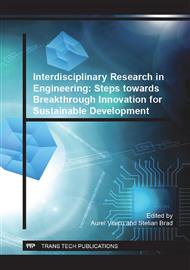[1]
K. Kümmerer, Antibiotics in the aquatic environment–A review–Part I, Chemosphere 75 (2009) 417-434.
DOI: 10.1016/j.chemosphere.2008.11.086
Google Scholar
[2]
S.A. Sassman, L.S. Lee, Sorption of three tetracyclines by several soils: Assessing the role of pH and cation exchange, Environmental Science and Technology 39 (2005) 7452–7459.
DOI: 10.1021/es0480217
Google Scholar
[3]
C. I. Brinzila, M.J. Pacheco, L. Ciríaco, R.C. Ciobanu, A. Lopes, Electrodegradation of tetracycline on BDD anode, Chemical Engineering Journal 209 (2012) 54-61.
DOI: 10.1016/j.cej.2012.07.112
Google Scholar
[4]
G. Gu, K.G. Karthikeyan, Interaction of tetracycline with aluminium and iron hydrous oxides, Environmental Science and Technology 39 (2005) 2660–2667.
DOI: 10.1021/es048603o
Google Scholar
[5]
H. Yamamoto, Y. Nakamura, S. Moriguchi, Y. Nakamura, Y. Honda, I Tamura, Y. Hirata, A. Hayashi, J. Sekizawa, Persistence and partitioning of eight selected pharmaceuticals in the aquatic environment: Laboratory photolysis, biodegadation, and sorption experiments, Water Research 43 (2009).
DOI: 10.1016/j.watres.2008.10.039
Google Scholar
[6]
S. Kim, P. Eichhorn, J.N. Jensen, A.S. Weber, D.S. Aga, Removal of antibiotics in wastewater: effect of hydraulic and solid retention times on the fate of Tetracycline in the activated sludge process, Environmental Science and Technology 39 (2005).
DOI: 10.1021/es050006u
Google Scholar
[7]
A. Boxall, D. Kolpin, B. Holling-Sorensen, J. Tolls, Are veterinary medicines causing environmental risks? Environ. Sci. Techol. 37 (2003) 287A-294A.
DOI: 10.1021/es032519b
Google Scholar
[8]
R. Hirsch, T. Ternes, K. Haberer, K.L. Kratz, Occurrence of antibiotics in the aquatic environment, Sci. Total Environ. 225 (1999) 109-118.
DOI: 10.1016/s0048-9697(98)00337-4
Google Scholar
[9]
S. Kim, P. Eichhorn, J.N. Jensen, A.S. Tweber, D.S. Aga, Removal of antibiotics in wastewater: Effect of hydraulic and solid retention times on the fate of tetracycline in the activated sludge process, Environ. Sci. Technol. 39 (2005) 5816-5823.
DOI: 10.1021/es050006u
Google Scholar
[10]
Y. Liu, X. Gan, B. Zhou, B. Xiong, J. Li, C. Dong, J. Bai, W. Cai, Photoelectrocatalytic degradation of tetracycline by highly effective TiO2 nanopore arrays electrode, J. Hazard. Mater. 171 (2009) 678–683.
DOI: 10.1016/j.jhazmat.2009.06.054
Google Scholar
[11]
R.A. Palominos, M.A. Mondaca, A. Giraldo, G. Peñuela, M. Pérez-Moya, H.D. Mansilla, Photocatalytic oxidation of the antibiotic tetracycline on TiO2 and ZnO suspensions, Catal. Today 144 (2009) 100–105.
DOI: 10.1016/j.cattod.2008.12.031
Google Scholar
[12]
P. Wang, P-S. Yap, T.T. Lim, C–N–S tridoped TiO2 for photocatalytic degradation of tetracycline under visible-light irradiation, Appl. Catal. A: Gen. 399 (2011) 252–261.
DOI: 10.1016/j.apcata.2011.04.008
Google Scholar
[13]
J. Jeong, W. Song, W.J. Cooper, J. Jung, J. Greaves, Degradation of tetracycline antibiotics: Mechanisms and kinetic studies for advanced oxidation/reduction processes, Chemosphere 78 (2010) 533–540.
DOI: 10.1016/j.chemosphere.2009.11.024
Google Scholar
[14]
M.D. Vendenyapina, Y.N. Eremicheva, V.A. Pavlov, A.A. Vendenyapin, Electrochemical degradation of tetracycline, Russ. J. Appl. Chem. 8 (2008) 800-802.
Google Scholar
[15]
A. Rossi, V.A. Alves, L.A. Da Silva, M.A. Oliveira, D.O.S. Assis, F.A. Santos, R.R.S. De Miranda, Electrooxidation and inhibition of the antibacterial activity of oxytetracycline hydrochloride using RuO2 electrode, J. Appl. Electrochem. 39 (2009).
DOI: 10.1007/s10800-008-9676-2
Google Scholar
[16]
H. Zhang, F. Liu, X.G. Wu, J.H. Zhang, D.B. Zhang, Degradation of tetracycline in aqueous medium by electrochemical method, Asia-Pac. J. Chem. Eng. 4 (2009) 568–573.
DOI: 10.1002/apj.286
Google Scholar
[17]
M. Miyata, I. Ihara, G. Yoshid, K. Toyod K. Umetsu, Electrochemical oxidation of tetracycline antibiotics using a Ti/IrO2 anode for wastewater treatment of animal husbandry, Wat. Sci. Technol. 63 (2011) 456-461.
DOI: 10.2166/wst.2011.243
Google Scholar
[18]
L. Ciríaco, C. Anjo, J. Correia, M.J. Pacheco, A. Lopes, Electrochemical degradation of Ibuprofen on Ti/Pt/PbO2 and Si/BDD electrodes, Electrochim. Acta, 54 (2009) 1464–1472.
DOI: 10.1016/j.electacta.2008.09.022
Google Scholar
[19]
M. Panizza, G. Cerisola, Application of diamond electrodes to electrochemical processes, Electrochim. Acta 51 (2005) 191.
DOI: 10.1016/j.electacta.2005.04.023
Google Scholar
[20]
I. Sirés, E. Brillas, Remediation of water pollution caused by pharmaceutical residues based on electrochemical separation and degradation technologies: A review, Environment International 40 (2012) 212-229.
DOI: 10.1016/j.envint.2011.07.012
Google Scholar
[21]
Ch. Comninellis, C. Pulgarin, Anodic oxidation of phenol for wastewater treatment, J. Appl. Electrochem. 21 (1991) 703-708.
DOI: 10.1007/bf01034049
Google Scholar
[22]
Ch. Comninellis, C. Pulharin, Electrochemical oxidation of phenol for wastewater treatment using SnO2 anodes, J. Appl. Electrochem. 23 (1993) 108-112.
DOI: 10.1007/bf00246946
Google Scholar
[23]
Ch. Comninellis, Application of synthetic BDD electrodes in electrooxidation, in Diamond Electrochemistry, Elsevier, Amsterdam (2005) 449-476.
DOI: 10.1016/b978-044451908-5/50022-x
Google Scholar


